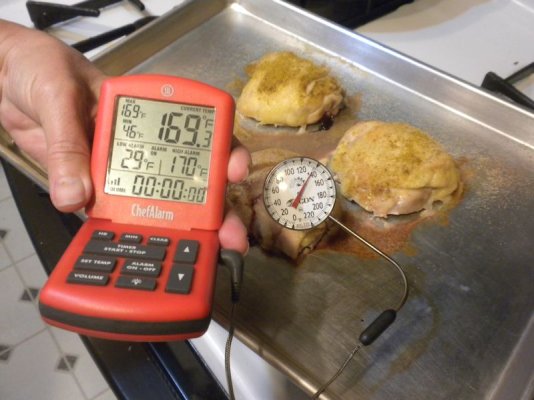The new one is the same. I think that the problem is that the probe is just too sensitive to position.
Last night I roasted a whole 4.75 pound chicken. I carefully positioned the probe into the middle of the thigh muscle, and baked it until the device beeped at 165 degrees.
I then took the probe out and put it in the breast so that the tip was centered in the breast, and not close to the bone. It then read 145 degrees. I tried a number of positions, and got readings from 145 to 170.
It's just not reliable that way. I can only use it to alert me to when the food is probably ready.
...
I think what you are seeing is that the old mechanical style is averaging the reading over a large area, and the new thermo-couple/thermistor-style is giving you very specific area temperatures.
From the sound of it, the probe is actually giving you accurate readings of those areas. They really vary between 145F-170F at the probe tip.
But maybe an average reading is more useful in this case?
I've noticed the same thing when cooking a turkey. I forget the numbers offhand, but they give one target for the breast and another for the thigh, maybe 15F different? Well I could easily get a 15F delta in readings by moving the probe position ever so slightly. It is still largely a guessing game.
If you are shooting for say 165F throughout, unless you cook the chicken for a very long time at a very low temperature (say 200F - but that may not be safe for other reasons, read up before trying this) to allow time for the whole thing to slowly rise to an even temperature, you will have hot/cold spots. Or cook it in liquid or steam for better heat transfer. You could still raise the temperature at the end to brown it.
I assume your chicken was totally defrosted, but still near fridge temperatures of ~ 38-40F? You can see how 300F or 350F air (poor heat transfer in air) will result in a dramatic temperature delta from surface to inside.
edit/add: I'll have to ask DW how she handles chicken. We have whole chickens pretty often, and she will use the oven in winter, grill in the spring-fall, and she just is not a rigorous/precise, procedure-driven type cook, yet, the chicken always comes out done near perfection. Now, if I could just get her to measure and record spices/flavorings, because there is just some magic combination of lemon juice, garlic, salt and maybe a little rosemary and thyme that is just
amazing, compared to very, very, very good/great. But she rarely duplicates the
amazing, though I am very, very, very happy with very, very, very good/great!
-ERD50





